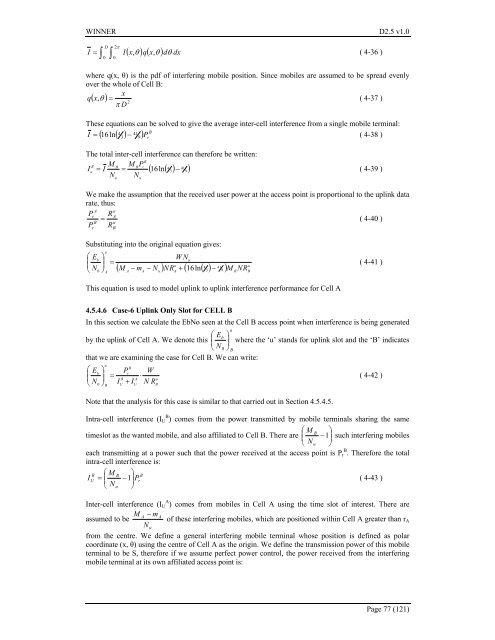IST-2003-507581 WINNER D2.5 v1.0 Duplex ... - Celtic-Plus
IST-2003-507581 WINNER D2.5 v1.0 Duplex ... - Celtic-Plus
IST-2003-507581 WINNER D2.5 v1.0 Duplex ... - Celtic-Plus
- No tags were found...
Create successful ePaper yourself
Turn your PDF publications into a flip-book with our unique Google optimized e-Paper software.
<strong>WINNER</strong> <strong>D2.5</strong> <strong>v1.0</strong>∫0∫2π( x,) q( x,θ )I = D I θ dθdx( 4-36 )0where q(x, θ) is the pdf of interfering mobile position. Since mobiles are assumed to be spread evenlyover the whole of Cell B:xq( x,θ ) = ( 4-37 )2π DThese equations can be solved to give the average inter-cell interference from a single mobile terminal:= 16ln4 −41( 4-38 )B( ( ) )I 3 9 P rThe total inter-cell interference can therefore be written:BB MBMBPrI = I = ( 16ln( 3)9)4 −41( 4-39 )uN NuuWe make the assumption that the received user power at the access point is proportional to the uplink datarate, thus:A uPrRAB =u( 4-40 )P RrBSubstituting into the original equation gives:u⎛ E ⎞bW Nu⎜ ⎟N=⎝ 0 ⎠A A u AlnAuu( M − m − N ) NR + ( 16 ( 3)9 ) 4 −41 M NRBB( 4-41 )This equation is used to model uplink to uplink interference performance for Cell A4.5.4.6 Case-6 Uplink Only Slot for CELL BIn this section we calculate the EbNo seen at the Cell B access point when interference is being generatedu⎛ Eb⎞by the uplink of Cell A. We denote this ⎜ ⎟Nwhere the ‘u’ stands for uplink slot and the ‘B’ indicates⎝ 0 ⎠ Bthat we are examining the case for Cell B. We can write:uB⎛ E ⎞ P Wbr⎜ ⎟B A uN= ⋅( 4-42 )⎝ 0 ⎠ IU+ IUN RBBNote that the analysis for this case is similar to that carried out in Section 4.5.4.5.Intra-cell interference (I B U ) comes from the power transmitted by mobile terminals sharing the same⎛ M ⎞Btimeslot as the wanted mobile, and also affiliated to Cell B. There are ⎜ ⎟−1such interfering mobiles⎝ Nu ⎠each transmitting at a power such that the power received at the access point is P B r . Therefore the totalintra-cell interference is:B⎛ M ⎞B BIU= ⎜ ⎟−1 PrN( 4-43 )⎝ u ⎠Inter-cell interference (I A U ) comes from mobiles in Cell A using the time slot of interest. There areMA− mAassumed to be of these interfering mobiles, which are positioned within Cell A greater than r ANufrom the centre. We define a general interfering mobile terminal whose position is defined as polarcoordinate (x, θ) using the centre of Cell A as the origin. We define the transmission power of this mobileterminal to be S, therefore if we assume perfect power control, the power received from the interferingmobile terminal at its own affiliated access point is:Page 77 (121)
















